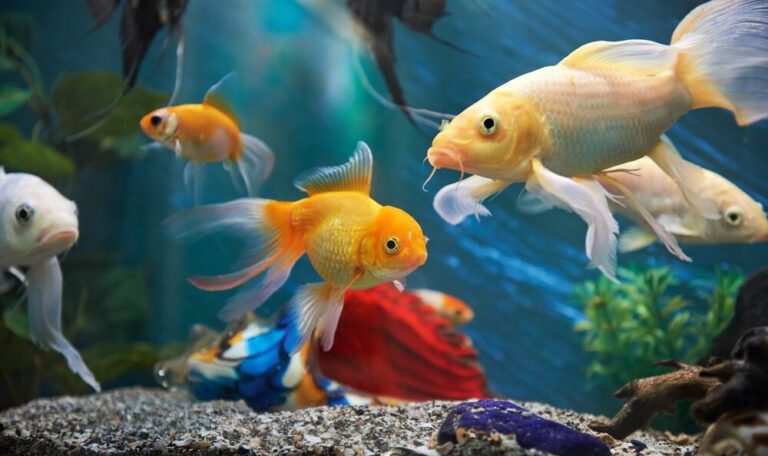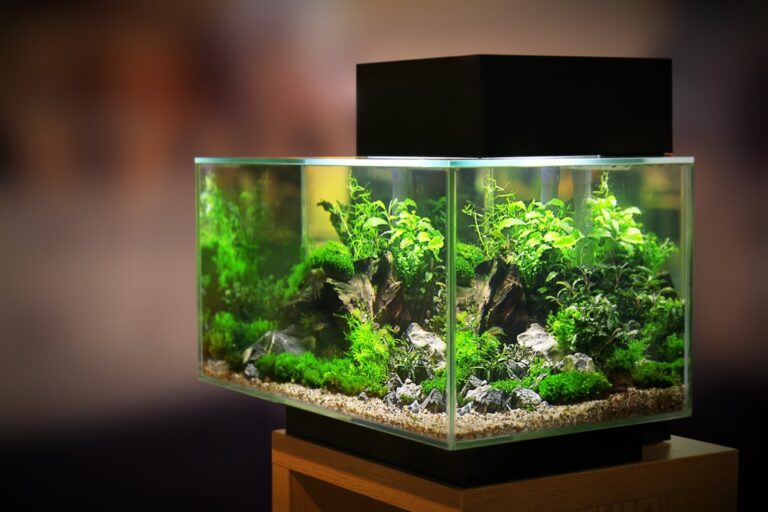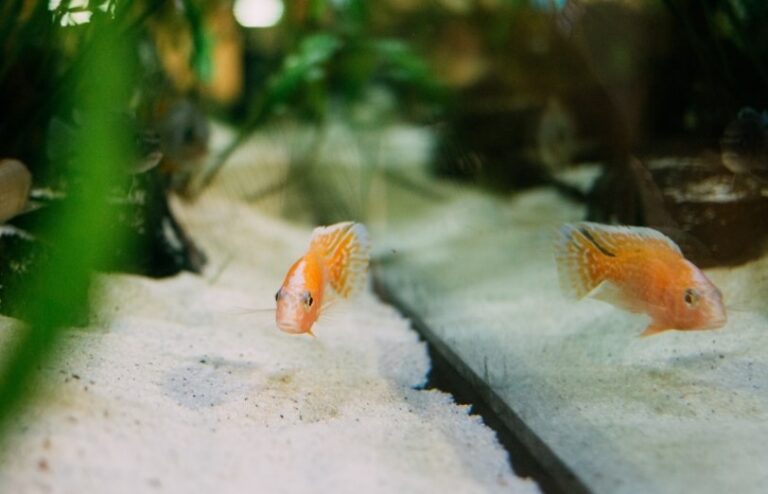Owning an aquarium that can clean itself is a great relief for you. Isn’t it? Both your energy and time will be saved. As a fish owner, you must have thought of getting rid of the duty of maintenance.
As a beginner, it might be a bit difficult for you to build a self-sustaining aquarium. In short, a self-sustaining aquarium requires a balanced cycle of fish species, aquatic plants, micro critters, and abiotic factors.
Here in this piece of writing, I will tell you the step-by-step process. From this reading, I expect that you will understand how to make a self-sufficient aquarium by yourself.
What is a Self Sustaining Aquarium?
The fundamental theme of a self-sustaining aquarium is that it has its own establishment of a self-sufficient food chain where both plants and fish benefit each other simultaneously.
This type of fish tank does not require the cleaning of substrate and replacement of the water frequently.
On the contrary, a normal aquarium’s water changing and substrate cleaning have to be done repeatedly. Moreover, a self-sustaining aquarium will protect your fish from getting a high level of stress.
The best thing about this aquarium is that you can actually save a large amount of time, hard work and definitely provide a very healthy ecosystem for your fish and plants.

Types of Self-Sufficient Aquarium
You can make your aquarium self-sufficient in different ways. The main thing about owning them is to have the best control. And also the best fusion of aquarium stuff that will create a self-sufficient ecosystem.
To be honest, It’s not possible for an aquarium to become 100% self-sufficient. However, it would ensure very low maintenance compared to any regular aquarium.
Three types of methods are well known for making a self-sufficient aquarium. And these are aquaponic fish tanks, gravity-based techniques, and traditional tanks with three-stage filtration.
Aquaponic Fish Tank
In this fish tank, there is the development of symbiotic relationships among the plants and fish. Usually, the plants are on the top and water is beneath them.
The waste from the fish becomes the plant’s food source. While plants turn the water cleaner for the fish. Not only that, nitrifying bacteria residing on the roots of the plants convert fish waste into nutritious aquatic plant food.
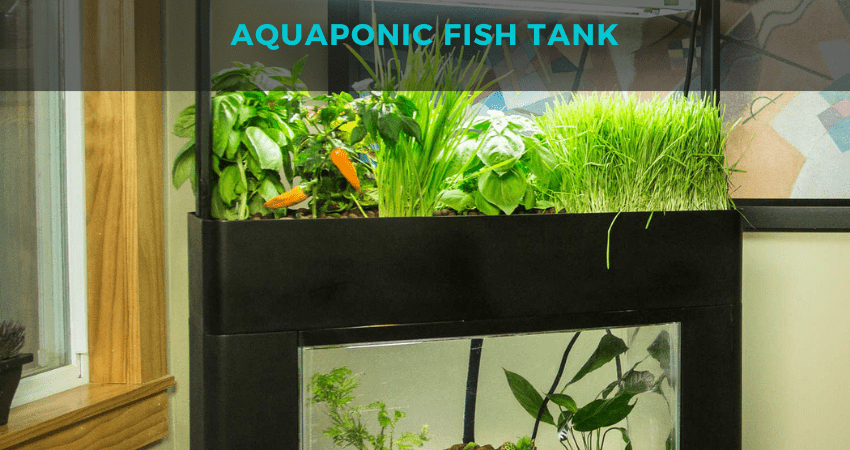
This is how you get cleaner water which is suitable for the fish to live. There are chances of adding your creativity to your fish tank. You can pick unique types of herbs or some other edible item along with the conventional aquatic plants.
It’s indeed an amazing method that you can also apply in your regular aquarium to convert into a self-sufficient aquarium.
Gravity Flow Technique
Though it’s not a very common fishkeeping practice, it’s a good method. It is based on the fundamentals of physics.
In this method, fish wastes and the food residue fall at the bottom while passing through the substrate layers and piled up in the reservoir tank. A tube is fitted inside the tank which connects the reservoir, extends all the way up to the top of the main tank, and finally goes outside.
The cleaning process of this fish tank is amazing and very easy. When you intend to clean, just pour some clean water that forces out the dirty water through the extended tube because of siphoning.
Here you don’t have the hassle of removing any decor, gravel to clean your self-sufficient aquarium.
Three-stage Filtration
This method is quite common among aquarists. It also requires low maintenance. All you need is a larger size aquarium filter for your fish tank.
Using the filter you can reduce the frequency of cleaning the filter kit and water changing of your fish tank. If you own a 40-gallon tank, just buy a filter that is made to do the job for 60-70 gallons of the tank.

Live plants help to create a proper organic ecosystem into the fish tank. You can also keep the toxic level of your fish lower by adding live plants.
Bio wastes generated from the fish decompose and form poisonous chemicals which the aquatic plants absorb very easily. In return, they provide oxygen to the water which keeps the water in a healthy state. Aquatic plants are outstanding natural chemical filtering systems to keep water in its best condition.
Step by Step Process of Making a Self-Sufficient Fish Tank
A self-sufficient fish tank is a brilliant and cost effective way to run a tank. And not to mention convenient as well! Most of the trouble you’ll encounter will be during its building phase.
So, in the following part, I will try to elaborate on all the steps one by one so that you are finally able to make a self-sufficient fish tank.
Step 1: Cleaning your aquarium tank
After buying the fish tank, you have to do an in-depth cleaning. An appropriate cleaning will remove all the contaminants that might be residing or sticking in your fish tank.
These contaminants are very harmful to your fish and aquatic plants. Also harmful for the ecosystem.
Step2: Build Substrate Bed
The most appropriate way to add substrate into your aquarium is by building multiple layers. The first level can be soil, then on top add some sand and finally put gravel on top of it.
The amount of each layer would depend on the size of your fish tank. In the case of a bigger size tank, you can add 2-inch sand and on top of that one-inch gravel.
However, if your tank is a smaller size or medium size, just add one inch of sand and half-inch gravel on the top.
Step 3: Fill the tank with water
Pure water free from any pollution is crucial for the life of your aquatic animals. Contaminated water will hamper the overall ecosystem of your aquarium tank. Filtered water or distilled water would be great for this purpose.
And if you are a pro aquarist then you can add access water from any of your extra aquariums which is in good condition. Because this water will be very helpful for the overall growth of your aquarium environment as it is full of nutrients.
Step 4: Add diverse aquatic plants
You need to choose plants that do really well with other species like fish, snails, etc. Don’t forget that the plant’s growth pattern is one of the important factors.
To bring more diversity to your pond you can buy plants that have different growth rates. For the bottom, you can use Hair Grass, Blyxa Japonica, and Rotala Green. You can add Cabomba, Amazon Frogbit, Hornwort, and Duckweed for surface growth. Java moss, Crystalwort can be used for branches.
Try to keep the right balance by not adding too many plants which might disrupt the normal process of the ecosystem. After adding all the plants wait for a few weeks and let them grow.
Finally, when the plants become mature and root fully grow then you can think about adding the fish.
Step 5: Install Aquarium Kits
Succeeding the successful adding of plants now it’s time to install a variety of kits that will control the overall ecosystem of your aquarium.
Kits including filters, temperature monitoring kit, air pumps, ammonia testing kit, and heater are a must for your self-sufficient aquarium.
It would be best to check and recheck whether all the components are working properly or not after the installation is complete.
Step 6: Cycle Your Self-Sufficient Aquarium
This step is the longest step among all these steps in making your self-sufficient aquarium. You need to have a good amount of patience.
It’s crucial because if you don’t do the cycling of your aquarium then your fish’s life will be at risk. You have to keep the aquarium running for at least a few weeks.
Throughout this process, water change is required to prevent the skyrocketing growth of algae in your tank. As the process gets longer, you need to change less amount of water.
Then bacteria and other microorganisms will form which will create the perfect ecosystem inside your self-sufficient aquarium.
Step 7: Add Micro Filters
Now you can use species like snails, daphnia, and micro-planarian as microfilters. They have a very important role to play in your self-sufficient aquarium.
First of all, they will keep your aquarium clean by eating the residue and algae. And also they become food for the carnivorous fish species of your tank.
Usually, two weeks is enough for the establishment of these critters.
Step 8: Livestock your Aquarium
By this time your fish tank already became nearly fully self-sufficient. Now you can add fish and shrimp into your aquarium. It’s better to stay on the safer side by keeping a smaller number of fish.
The target should be to keep the nitrate level low in the aquarium. If there is too much fish then there will be higher nitrates in the water. You can slowly and gradually increase the number of fish.
It would be best to add fish species that have a low bioload. Cleaner fish are good for your aquarium too.
Step 9: Installing an Automatic Feeder
This automatic feeder is very helpful for your overall comfort. Though it’s fun to feed your own buddy with your own hand, sometimes you might not have enough time. And as a result, your pet fish might become weak, ill because of improper feeding.
Even if you want to go for a trip then they will be deprived of food. Undoubtedly adding an automatic feeder into your self-sufficient aquarium will be great for the fish.
When you are not present, it will be able to provide food to your water buddies with a timely and precise amount of food. It will also prevent them from overfeeding and prevent the chance of sudden death.
Things You Need to Make a Self-Sufficient Aquarium
To make anything you need some specific raw materials. The same goes for a self-sufficient aquarium. Let me tell you the list and talk about them in detail in below
Fish Tank
The very first thing you have to decide is what would be the size of your fish tank. Please keep in your mind that the size of the tank will play a vital role in the overall maintenance and take care.
For the proper setup of your self-sufficient aquarium, the right size tank is important for the ecosystem.
Smaller size tanks are good for beginners But then again a larger tank is easy to maintain because you can add different types of species. By doing this you can keep them close to an accurate water-fish-plant ratio.
A water-holding range of 20-300 gallons is the ideal size for such an aquarium.
Aquarium Substrate
Some amount of soil, sand, and gravel are a must for your aquarium. You can easily find these items. A group of people has a tendency to underestimate the role of the substrate. But in reality, it’s very important for a self-sufficient fish tank.
It not only helps the growth of the root of the plants but also helps to grow the required amount of bacteria for the fish aquarium. Substrates also prevent your plants and the filtering system from getting in touch with the bacteria.
A mineral-rich substrate will help the proper growth of your aquatic plants.
Water
A self-sufficient aquarium requires properly treated water. The water of the tank needs to have an explicit amount of pH level, temperature, and hardness according to the fish that you have intended to put in your aquarium.
You can’t compromise the use of high-quality water. A pH level of 6.8 – 8.0 is a safe range for the freshwater aquarium. On the other hand for a saltwater aquarium a pH level of 8.0 – 8.4.
It would be best for your tank’s ecosystem if you can maintain a temperature between 72-80 °F. You need to buy a high-quality water testing kit.
With the water, it would become very easy for you to check the level of nitrate, ammonia, nitrite, and pH level.
Live Aquatic Plants
Let me remind you that a self-sufficient aquarium means an established natural food chain. So you really need to bring the right plants for your aquarium.
If your tank is a bit smaller, then you need plants that are kind of dwarf plants. Try to choose those plants which are easy to maintain.
Plants that need low amounts of light are very friendly and compatible with a self-sufficient aquarium. The value added by plants is very high. They will help to generate a well-balanced healthy ecosystem inside your fish tank. So you need to be careful in choosing the aquatic plants.
When there is a precise amount of plant in the fish tank it will do a fantastic job for you. And that is you don’t need to change the water frequently because the plant will absorb a reasonable amount of ammonia and nitrates.
Aquatic plants are also a playing and hiding zone for the smaller fish. Moreover, it also works as a part of your aquarium’s decoration.
One thing you must remember and that is your aquatic plant will be able to survive if you can ensure proper lighting and temperature of your self-sufficient aquarium.
Additional Read:
Aquarium Filtration System
A filter system is very important for your self-sufficient aquarium. They not only clean the water of the fish tank but also provide enough oxygen for your finny friends.
Variations of filters are available in any pet shop. They may differ in size and shape. Some of the filters are embedded with air pumps and some of them are not.
A fish tank that is planted properly and which has a three-stage filtering system will efficiently function as a self-sufficient aquarium. Please don’t forget that you need to install filters according to the size of your aquarium.
An inappropriate filter or filtering system will not be able to keep the smoother condition of the ecosystem of the fish tank. It’s highly recommended to buy the high-tech filters because they have an alert system that will prevent any unwanted environment in your self-sufficient aquarium.
But if you can’t afford high-tech filters and install the regular ones then you need to check them routinely.
Lighting To Support Aquatic Plants
Aquarium lighting is very important and plays a major role to maintain the proper health of the aquatic plants. Aquatic animals and plants need as much light as possible.
Fluorescent lights are a good option. It will provide the required amount of UV light for your fish tank ecosystem. If you find artificial UV light costly then you can keep your tank under at least 6 hours of UV light which would be sufficient for them. Light from any direction is absolutely okay.
LED lighting is another option you can use for your aquatic plants and fish. A high powerful LED or a very weak LED light can be very dangerous for a few plants. And if some plants die then the algae of the tank can bloom.
Decoration (Optional)
Definitely, decorative items are not an integral part of an aquarium. There are tons of ornamental stuff available in many online shops.
However, the fun toys will not provide any benefit to the ecosystem. They are installed because it’s fun to look at those moving toys. Before putting any such decorative item you should read the label thoroughly to make sure that no harmful content or contamination is present.
Real shells and reef pieces collected from the sea can be also placed in your self-sufficient aquarium for beautification. But you need to clean them before putting them into the tank.
One recommendation from myself would be to ignore decor which has too much color on them.
Right Selection of Fish
Now it’s time to add the center of the attraction of your aquarium. This is the last thing that is most needed for a self-sufficient aquarium.
There are some specific criteria of fish that will ensure the optimum level of the ecosystem of the tank. You need to choose according to the size of the tank, size of the fish, and required environmental conditions.
Moreover, some fish can only survive in a specific range of temperature. Another thing you need to check is that all the diverse species that you are going to put in your fish tank should have compatibility with each other. An aggressive fish species might kill other fish so it’s very important.
Fish that can clean the tank by eating algae would be highly beneficial for your aquarium. It will reduce the burden of changing the tank water frequently.
In the following, I am giving some fish’s name and their description.
Swordtail
A vibrant color fish that brings diversity to your aquarium. Despite not being good cleaners they get along very easily with other fish species. Their normal lifespan is long and also the dietary and environmental conditions are quite flexible.
Platies
These fish are not hard to maintain. Not only are they colorful but also very community-based fish. They will also help to control the growth of algae by eating them.
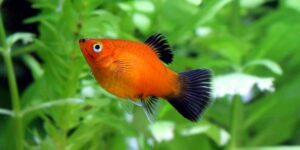
Neon Tetra
One of the brightest color fish. If they have enough space then they will roam around in your aquarium in groups. The maintenance of this fish is pretty low and also they have a long lifespan making them a very good choice as an aquarium fish.

Bristlenose Plecos
They do look a bit weird and good for keeping in a larger size tank. As they are big in size they also eat a good amount of algae. If you pet them just make sure that there is a sufficient amount of algae in the fish tank.
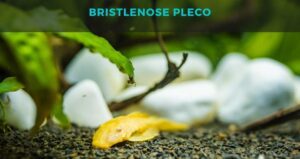
Mollies
They are well known for their adaptation and being friendly neighbors. The size of this fish is a bit smaller. They usually eat algae and are an excellent addition to your aquarium.
Bloodfin Tetra
These fishes are very easy to maintain. Because of their friendly nature, they are famous amongst aquarists. Indeed a wonderful fish to be in your self-sufficient aquarium.
Hoplo Catfish
The bottom of your aquarium would be their favorite place. They not only clean your tank by eating algae but also by eating drops from their neighbors.
Maintenance of Self Sustaining Aquarium
Just because you have a self-sufficient aquarium does not mean that you are totally free from the look after of your fish tank. It enables you to save a large amount of time and hard work but still, they need your attention and care.
Here I am giving you some ideas to clean your tank to keep both your plant and fish in a healthy state.
Altering the water of the tank
When you are going to replace the water of your self-sufficient aquarium you have to be careful. Any extreme change in the water temperature might be very harmful to your fish.
Removal of too much bacteria will seriously hamper your smooth food chain. 10%-20% change of the water from your at a time is okay. And that should be done at least between a gap of two weeks.
Anything more than that will hurt the ecosystem of your aquarium. But by following that you can keep your water clear and compatible with your aquarium’s ecosystem.
Controlling the algae growth
After keeping algae eating fish species it might be the case that there is an excessive amount of algae in your fish tank.
You can vacuum the tank’s gravel layer while changing the water. It will also remove the algae and food that are residing on the last layer.
Another way you can remove algae is by using a filter foss or magnetic pad.
Removing Dead Fish
Death is just a part of every living being’s life. No matter how much you take care of your fish they are going to die because of normal aging.
Delaying the process of removing dead fish will be harmful to your other fish and plants. If they start to decompose then it will alter the level of ammonia and nitrate.
So it’s better to check that all the fishes are okay or not. It will take just a few seconds if you know the number.
So sometimes checking with a high-quality water kit is good for the safety of your self-sufficient aquarium overall balance.
Benefits of having a Self Cleaning Aquarium
It’s true that to create a self-sufficient aquarium is a bit of a complex task. But once it’s done it’s very easy to manage it. Here I will show you some benefits of making a self-sufficient aquarium.
Save your Maintenance Time
Undoubtedly, fish petting is one of my amazing hobbies. It’s fun and eye soothing to watch your fish moving around in your tank and playing with each other. But with that fun there comes a cost and that is the hard maintenance.
If you don’t change the fish tank water, clean the air pump, remove the excess algae from gravel by vacuuming and changing the filter kit then there would be some serious threat to your fish and aquatic plants. And all these are not easy to do and obviously, they are time-consuming too.
Here comes the advantage of having a self-sufficient aquarium as an aquarist. It reduces the overall maintenance time significantly and allows you to engage in your other productive task.
Relaxed Fishkeeping
If you own a self-sufficient aquarium then you don’t need to think twice, thrice, or even think of calling someone to take care of your aquarium before you go for a vacation.
Because they can function on their own for a very long time. So it’s a very relaxing way of petting your fish.
Stability of your tank’s ecosystem
Indeed it is a stressful task to clean your fish tank frequently. Not only that it creates stress on you, but also your fish suffer too.
Every time you need to change your water or vacuum substrate layers, you are going to lose a significant amount of bacteria which are beneficial for your fish tank ecosystem.
But if you have a self-sufficient aquarium all these problems will not arise at all.
Healthy Environment
A self-sufficient aquarium usually has a healthy environment inside it. The near-perfect living condition allows your fish and aquatic plants to stay in a very good state.
The best thing about this is that in such a fish aquarium the probability of getting any infections or disease is very low.
Drawbacks of A Self-Sufficient Aquarium
Making a self-sufficient aquarium is obviously a long-term investment. But just like any other thing it has its own negative sides.
One of the main problems with these fish tanks is that they are very expensive. It would be quite tough for an average person to afford the cost.
Another drawback is that it will take a very long time for the overall setup of your aquarium.
And the last one is that sometimes it becomes a bit harder to select the right fish and aquatic plants according to your choice. Because they have to be compatible with each other or the ecosystem will collapse.
Final Words
A self-sufficient aquarium is an exotic aquatic ecosystem for fish, aquatic plants, and other microorganisms. That’s why it is a bit more special and costly than a regular aquarium.
Anyway, you need to be cautious as a little damage can harm the whole ecosystem of the fish tank.
I am very much optimistic that after reading all the steps you have acquired enough knowledge on how to make a self-sufficient aquarium.

